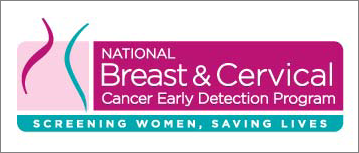 When navigating in NYC hospitals, I met many women who were uninsured or under-insured and did not meet Medicaid eligibility requirements. They needed breast and cervical screenings, but could not afford the out of pocket costs associated with these screenings.
When navigating in NYC hospitals, I met many women who were uninsured or under-insured and did not meet Medicaid eligibility requirements. They needed breast and cervical screenings, but could not afford the out of pocket costs associated with these screenings.
It was always a relief to be able to refer them to a program that could give them the screenings they needed -The National Breast and Cervical Cancer Early Detection Program. This CDC initiative, which funds state and local providers to provide breast and cervical screenings, has brought these screenings to the neighborhoods and maked them accessible to women in need. I am pleased to share this news release, issued by the CDC, that speaks to the success of this screening program.
U.S. Centers for Disease Control and Prevention, news release, Aug. 6, 2014: Millions of underserved women in the US have benefited from CDC’s breast and cervical screening program,The National Breast and Cervical Cancer Early Detection Program.
More than 4.3 million women with limited access to health care received breast and cervical cancer screening and diagnostic services in the first 20 years of the CDC’s National Breast and Cervical Cancer Early Detection Program (NBCCEDP).
From 1991 to 2011, 56,662 breast cancer, 3,206 cervical cancers, and 152,470 precancerous cervical lesions were detected. More than 90 percent of these women received appropriate and timely follow-up care, according to the CDC report published online and appears in the Aug. 15, 2014, supplement edition of Cancer.
“Today, millions of women have benefited from the timely screening and diagnostic services offered by CDC’s National Breast and Cervical Cancer Early Detection Program,” said Ursula E. Bauer, Ph.D., M.P.H., director, CDC’s National Center for Chronic Disease Prevention and Health Promotion. “This program has made tremendous contributions in public health through strengthening partnerships, health care collaborations, and quality of care, but also at a personal level by serving women directly.”
The Cancer supplement, titled National Breast and Cervical Cancer Early Detection Program: Two Decades of Service to Underserved Women, contains 13 new papers evaluating multiple aspects of the NBCCEDP and shows consistent value in the program, including beyond its original purpose of detecting cancers in underserved women.
The papers describe the number of actual cancers detected, outreach, education, and health care collaboration activities. Data quality, evaluation, cost estimates, and suggestions for future programming are also noted. This is the first time detailed information has been published describing the program’s screening activities– and strategies beyond screening– used to reach underserved populations. Also included are state examples of successful interventions.
Among the findings:
- Public education and outreach help raise awareness and address barriers to care.
- One of the uses for data reported to CDC is quality assurance, which monitors the quality of services provided by the NBCCEDP-funded programs. This monitoring can help identify issues with the services, determine the causes of the issues, and check whether these issues were corrected.
- The estimated cost of providing cancer screening and diagnostic services through the NBCCEDP was $145 per woman. Cost estimates can be useful in future program planning.
- Performance management and program effectiveness strategized improved service delivery through use of data, strong quality indicators, and investment in the program to ensure women are receiving timely screening, diagnostic follow up, and referral to treatment when needed.
- Partnerships at national and local levels with national organizations and their members, community-based organizations, government agencies, tribes, healthcare systems, and professional organizations have played a critical role in achieving NBCCEDP goals.
- The NBCCEDP has made tremendous contributions to breast and cervical cancer screening for Alaska Native/American Indian women and strengthened local tribal screening capacity.
The papers show how the NBCCEDP can support health care systems, especially as access to health care improves for millions of people through the Affordable Care Act. These partnerships can support the use of appropriate and high-quality breast and cervical cancer screening through broader use of organized approaches to screening and increase population-level screening.
The NBCCEDP was established by Congress in 1990 to provide quality breast and cervical cancer screening and diagnostic services to low-income, uninsured women. Over 24 years, the program has established strong capacity with the clinical care system to become the only nationwide cancer screening program serving all 50 states, the District of Columbia, five U.S. territories, and 11 tribes or tribal organizations.
For the online articles, go to http://onlinelibrary.wiley.com/doi/10.1002/cncr.v120.S16/issuetoc. To find out more about the NBCCEDP, visit http://www.cdc.gov/cancer/nbccedp/.

